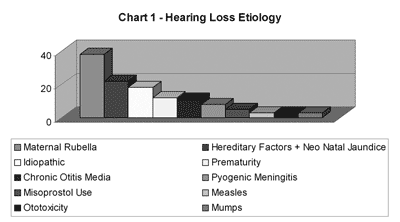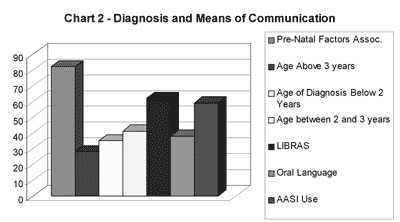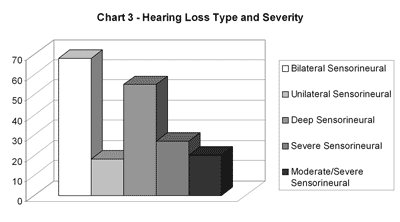INTRODUCTIONThe ear is an organ that enables human beings to exert one of the noblest superior functions: communication. It is through language that we have been able to organize the universe, to understand the world around us, to comprehend our fellow human beings, to convey and examine thoughts and feelings of others, to interact with the environment and to acquire knowledge1.
Language is a highly complex process, as it relates to the elaboration and symbolization of human thought to allow communication between men. The ability to understand oral language must be considered one of the most important measurable aspects of human auditory function2.
In hearing impaired children, language acquisition and development process can be put in harm's way, should diagnosis and intervention not be done in a timely manner.
Research has also indicated the existence of a critical period that occurs within the first years of a child's life for speech acquisition. Lack of proper auditory stimulation in childhood may preclude the complete development and maturation of central auditory pathways3.
According to the WHO, 42 million people above the age of three bear some sort of moderate to profound hearing loss. Over 4% of the children considered to be at high risk are diagnosed with moderate to profound hearing loss4.
This paper aims at characterizing the etiological profile of hearing impairment at a reference center for the treatment of hearing challenged children and adolescents, so as to enable future prevention and care measures.
The identification of the main etiologic factors surrounding infantile deafness is an important diagnostic tool to allow the proper implementation of public health procedures and, consequently, of effective prevention measures and guidance to families in regards of hearing impairment.
MATERIALS AND METHODThe APADA - BA (Association of Parents and Friends of the Hearing Challenged of the State of Bahia) is a non-profit organization that provides specialized support to deaf children and adolescents by means of psychopedagogy, speech and hearing therapy, psychology, and employment bureau services. It also counts on the support of a public secondary school that works within APADA premises where teachers, aside from the traditional curricula, teach Brazilian Sign Language (LIBRAS) to students.
A case series cross-sectional study was carried out. All selected children and adolescents were interviewed three times (one general interview and two evaluation sessions). The adopted screening protocol comprised interviews and speech and hearing evaluations, in which the main etiologic factors were analyzed by assessing the subjects' prenatal history, their neuropsychomotor development, and test results brought in by their families and those already available from the subjects' charts.
The items analyzed were distribution by gender, age of diagnosis, hearing loss severity, age of hearing aids introduction, and speech and hearing rehabilitation sessions attendance.
The project was submitted to the Research Ethics Committee of the Federal University of Bahia, at the Medical School Graduate Department, and was granted permit # 89/ 2004, knowledge area code 4.07, level D, Group III.
RESULTSFifty-three subjects were chosen from the original sample of eighty-seven who underwent speech and hearing screening. Their parents attended all three interview and evaluation sessions. The main etiologic factor responsible for hearing impairment in the assessed population was mother's rubella, accounting for 32% of deafness cases, followed by pyogenic meningitis with 20%, idiopathic reasons with 15%, premature birth with 9%, inheritance (deaf father or mother) and neonatal jaundice with 6% each; chronic otitis media accounted for 4%, use of misoprostol during pregnancy, measles, ototoxicity, and mumps were also present, each with 2% (Chart 1).
Thirty-one (58%) of the 53 subjects were males and 22 (42%) were females. Ages varied between 4 and 18 years. In the speech and hearing evaluation interview the main causes for hearing loss onset on the prenatal, perinatal, and postnatal periods were addressed, the age of diagnosis, the type of hearing aid device used, and the subjects' ability to use either oral language or the Brazilian Sign Language. Results are described below (Chart 2).
Prenatal factors were identified in 43 of the 53 subjects in the sample (81%). Age of diagnosis < 2 years - 34%, between 2 and 3 years - 40%, and above 3 years of age - 26%. The hearing aid device found predominantly was AASI (58%), while 42% of the children never wore or discontinued the use of the device for various reasons (device broke, could not afford to buy batteries), and had not worn it in over 6 months.
The vast majority of the subjects used the Brazilian Sign Language as their main form of communication (62%), while only 38% used oral language as their principal means of communication.
As for the type of hearing impairment, the entire sample presented sensorineural hearing impairment and 33 individuals (62%) presented audiometric configuration compatible to bilateral loss, while only 10 children (18%) had unilateral loss. Thirty subjects in the sample (56%) had profound loss, 25% of them had severe loss, while 19% presented moderate to severe loss. (Chart 3)

Chart 1. Diagnosis and Form of Communication.

Chart 2. Hearing Impairment Etiologic Factors.

Chart 3. Type and Degree of Hearing Impairment.
According to Walch et al.5, the data gathered from the subjects' parents on the inheritance-related, prenatal, perinatal and postnatal causes for impairment onset is the most valuable information to establish disease etiology.
Infantile development depends basically on two aspects: the child's individual characteristics - organic and emotional conditions and environmental characteristics - social and familial conditions; and learning opportunities. The global development - cognitive, linguistic, and emotional - is determined by the interaction between these various factors6.
Inherited hearing impairment is considered to be of prenatal origin, and in this stage fetal infections play a role of paramount importance as causal factors. The main fetal infection to cause hearing impairment is rubella. However, with the introduction of immunization programs the incidence of this disease has decreased in developed countries in the last few decades. But rubella and other fetal infections are still quite prevalent in the Brazilian northeastern states, and should always be taken into consideration in the etiologic analysis of infantile congenital hearing loss7.
Later in childhood, the biggest cause of hearing impairment is meningitis, a disease that may lead to profound hearing loss. About one out of every one thousand newborns present hearing loss, and two out of every one thousand children begin to experience deafness within the first three years of life. These facts by themselves justify audiologic investigation in children not only when they are born, but also throughout their first years of life8.
The current trend in regards to hearing impairment points to diagnosis, etiology, and treatment within the boundaries of pediatric otological and otoneurological diseases, apart from neonatal and infant screening tests aiming at early hearing rehabilitation9.
One of the biggest challenges in pediatric audiology lies in the cases of hearing losses of unknown etiology in childhood. Parents must be thoroughly interviewed. Information coupled with data from audiologic tests can lead to the development of an etiologic diagnosis of the patient's hearing impairment. It is also recommended to include non-audiologic tests such as serology, imaging, ophthalmologic examination, and genetic evaluation. A broad interdisciplinary approach may offer valuable insight into uncovering unknown etiologies10.
Changes in the prevalence rates of infantile hearing impairment have been observed throughout the years. And many and different are the epidemiological aspects to be considered from country to country and even inside one same nation. In most developed countries the pediatric health care systems monitor children's development and offer follow-up and rehabilitation programs11.
Broad educational programs must be implemented to advise health care workers of the harm brought about by hearing impairment. The development of informational material can play a key role in the early detection of hearing impairment12.
CONCLUSIONThe etiologic identification done at the APADA population unveils many of the main factors at play in hearing impairment. It also calls for further studies in other centers so that a nosological profile of deafness can be properly outlined and input is provided to public health policy makers. The occurrence of diseases such as measles during pregnancy, and infectious contagious diseases such as meningitis, must be minimized so as to mitigate the impact of infantile hearing impairment.
ACKNOWLEDGEMENTSThe authors would like to thank the directors, parents, and teachers for their undying dedication and commitment for the auditory rehabilitation of the children and, above all, the students for their invaluable cooperation.
REFERENCES1. Roslyng-Jensen AMA. Importância do diagnóstico precoce na deficiência auditiva. In: Lopes Filho O. Tratado de Fonoaudiologia. São Paulo: Roca; 1997. p. 297-309.
2. Mendonça CL. Diagnóstico Precoce Na Deficiência Auditiva. Monografia de Conclusão de Curso. Centro de Especialização em Fonoaudiologia Clínica. Recife; 1999.
3. Stelmachowicz PG, Gorga MP. In: Cummings CW et al. Otolaryngology Head and Neck Surgery. 3rd ed. St. Louis: Mosby; 1998. p.401-17.
4. AMERICAN ACADEMY OF PEDIATRICS. Joint Committee on Infant Hearing, Position Statement. Pediatrics 1982; 70: 496-7.
5. Walch C, Anderhuber W, Köle W, Berghold A. Bilateral sensorineural hearing disorders in children: etiology of deafness and evaluation of hearing tests. Int J Pediatr Otorhinolaryngol 2000; 53:31-8.
6. Zorzi JL. Aquisição da linguagem infantil - Desenvolvimento Alterações - Terapia. São Paulo: Pancast; 1993. p. 105.
7. Parving A. As deficiências auditivas na infância - epidemiologia e etiologia. Anais Nestlé 1995; São Paulo 50: 13-7.
8. Sibbaldi A. Pesquisa (screening) da hipoacusia na infância. In: Sih TM (Ed). Manual de otorrinolaringologia pediátrica. São Paulo: IAPO; 1997. p.291-8.
9. Lalwani AK, Gundfast KM. Pediatric otology and neuro otology. Philadelphia: Lippincott-Raven, 1998. Eletronic Britsh Medical. Journal Publishing Group: http:// www.bmj.com.2000.
10. Oliveira TMT, Casarin MT, Souza MA, Marquett SCE, Barros TN. Atitudes de médicos pediatras em relação à audição infantil. Pediatria Atual 1998; 11(9): 48-56.
11. Zakzouk SM. Epidemiology and etiology of hearing impairment among infants and children in a developing country. J Otolaryngol 1997; 26: 335-44.
12. Anjos LPA, Queiros F, Pereira MC, Brandão M, Melo A, Lucena R. Prognóstico audiológico tardio relacionado à meningite em lactentes. Arq Neuropsiquiatr 2004; 62(3-A): 635-40.
1 Assistant Speech and Hearing Therapist at APADA/ BA (Association of Parents and Friends of the Hearing Challenged of the State of Bahia); Master's student of Medicine and Health. Emphasis: Neurosciences - Medical School at UFBA, Resident physician in Neonatology - Ministry of Health / UNEB
2 Master's student of Medicine and Health. Emphasis: Neurosciences - Medical School at UFBA.
3 Assistant Speech and Hearing Therapist at APADA/ BA (Association of Parents and Friends of the Hearing Challenged of the State of Bahia).
APADA- Associação de Pais e Amigos dos Deficientes Auditivos - Bahia
Mailing address: Rua Gercino coelho 2ª travessa 09. Matatu-Brotas 40255171 Salvador Bahia
Paper sent to the ABORL-CCF SGP (Management Publications System) on June 31st, 2005 and accepted on September 12th, 2005.


